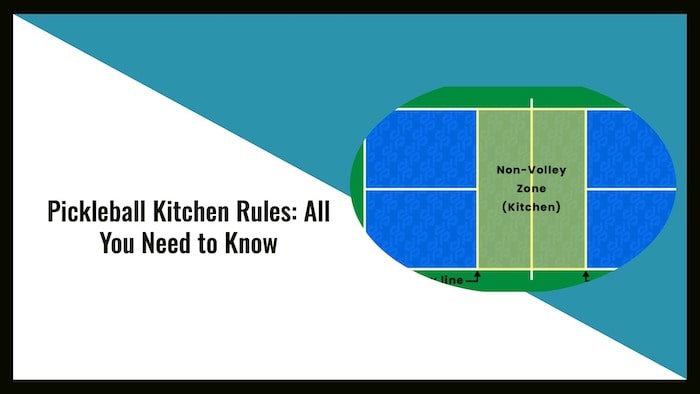Welcome to the fascinating and quickly expanding sport of pickleball, which combines aspects of tennis, badminton, and table tennis. As pickleball becomes increasingly popular, more and more people are drawn to the kitchen, also known as the non-volley zone, which is an important area on the pickleball court.
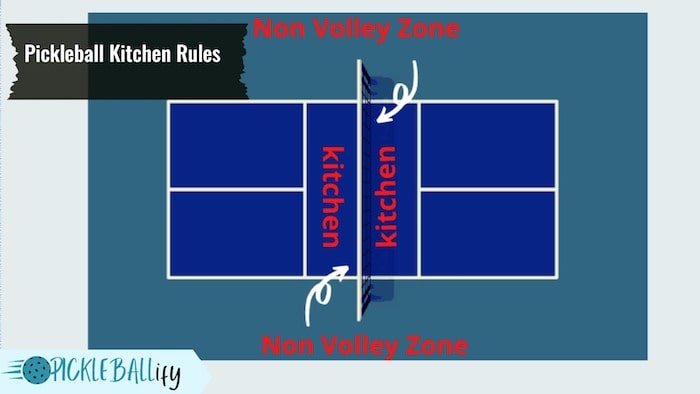
To play the game successfully and avoid penalties, participants must follow the kitchen’s set of rules. In this article, we’re going to break down everything you need to know about pickleball kitchen rules, from the basics to the nitty-gritty details.
Whether you’re a newbie just getting started or an experienced player seeking to brush up on the rules, this article will provide you with the knowledge you need to confidently navigate the pickleball kitchen.
What is the Pickleball Kitchen and Why Does It Matter?
The pickleball kitchen, also known as the non-volley zone or NVZ, is the space right by the net on both sides of the court. It is marked by a line that is 7 feet away from the net and extends from sideline to sideline. The line is considered part of the kitchen, so any contact with it counts as being in the kitchen.
The pickleball kitchen rule states that a player must hit all volleys from outside of the kitchen. A volley is when you hit the ball in mid-air before it bounces. If you are in the kitchen or touching the kitchen line when you volley the ball, you commit a fault and lose the point. You can enter the kitchen at any time during a rally, as long as you are not volleying.
The pickleball kitchen rule was created to prevent players from standing at the net and smashing everything downward, which would make the game unplayable and unfair. The rule also adds a layer of strategy and skill to the game, as players have to decide when to approach the net, when to retreat, and when to hit soft or hard shots.
Pickleball Kitchen Strategy: How to Dink and Lob Effectively
One of the most important skills to master in pickleball is how to dink and lob from the kitchen. These are shots that require finesse and touch, and they can give you an edge over your opponents if you know how to use them wisely.
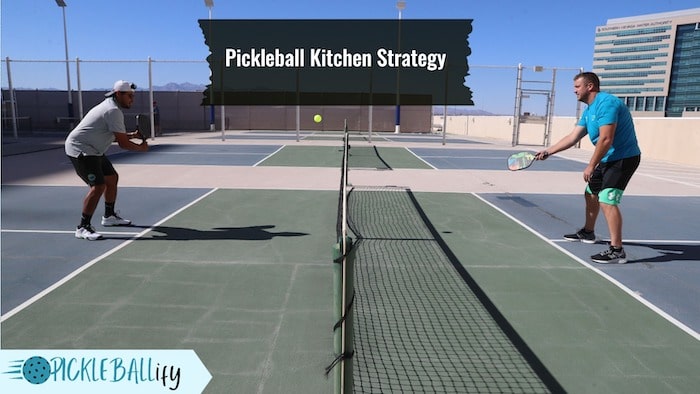
A dink is a soft shot that lands in your opponent’s kitchen, forcing them to hit up on the ball. A lob is a high shot that goes over your opponent’s head, forcing them to back up or chase after it. Both shots can create openings for you to attack or win the point.
Here are some tips on how to dink and lob effectively:
- Dink with purpose – Don’t just hit the ball softly over the net without a plan. Aim for a spot that will make your opponent move or stretch, or that will expose their weakness. For example, you can dink crosscourt to create an angle or dink down the line to catch them off, guard.
- Dink low and deep – The ideal dink should barely clear the net and land as close to the kitchen line as possible. This will make it harder for your opponent to return it with power or angle, and it will give you more time to react and get ready for the next shot.
- Lob with surprise – Don’t lob too often or too predictably, or your opponent will anticipate it and smash it back at you. Lob when your opponent is close to the net or out of position, or when you see an opening behind them. Lob with enough height and depth to make it difficult for them to reach or return it.
- Lob with spin – Adding some topspin or backspin to your lob can make it more effective and deceptive. Topspin will make the ball drop faster and bounce higher, while backspin will make the ball float slower and bounce lower. Experiment with different spins and see how they affect your lob.
How to Avoid Breaking the Pickleball Kitchen Rule and Losing Points
Breaking the pickleball kitchen rule is one of the most common mistakes that beginners make. It can also cost you points and games if you are not careful. Here are some tips on how to avoid breaking the kitchen rule and losing points:
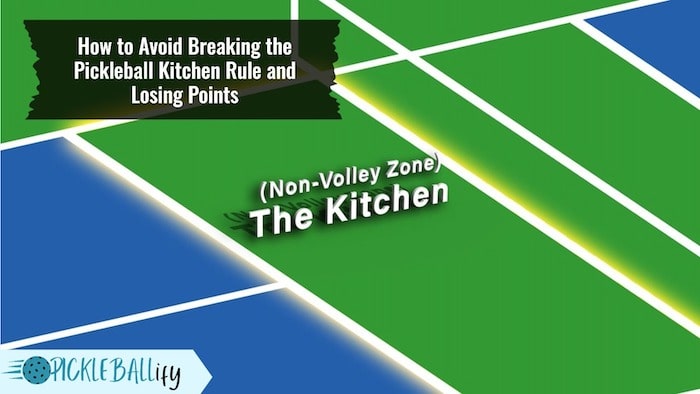
- Know where you are on the court – Always be aware of your position relative to the kitchen line. Use visual cues such as shadows, cracks, or markings on the court to help you stay out of the kitchen when volleying.
- Know where your partner is on the court – The kitchen rule applies not only to you but also to your partner and anything physically connected to you. This means that if your partner touches the kitchen or the line while you are volleying, it is a fault. Communicate with your partner and coordinate your movements to avoid this situation.
- Know where your paddle is on the court – The kitchen rule also applies to your paddle and anything you are wearing or carrying. This means that if your paddle touches the kitchen or the line while you are volleying, it is a fault. Keep your paddle up and away from the kitchen when volleying.
- Know where your momentum is taking you on the court – The kitchen rule also applies to your momentum after volleying. This means that if you land in or touch the kitchen or the line after volleying, it is a fault. Control your momentum and balance when volleying and avoid jumping or lunging into the kitchen.
Common Mistakes and Misconceptions About the Pickleball Kitchen Rule
The pickleball kitchen rule can be confusing and challenging for beginners and even intermediate players. There are some common mistakes and misconceptions that players make when playing in the pickleball kitchen. Here are some of them and how to avoid them:
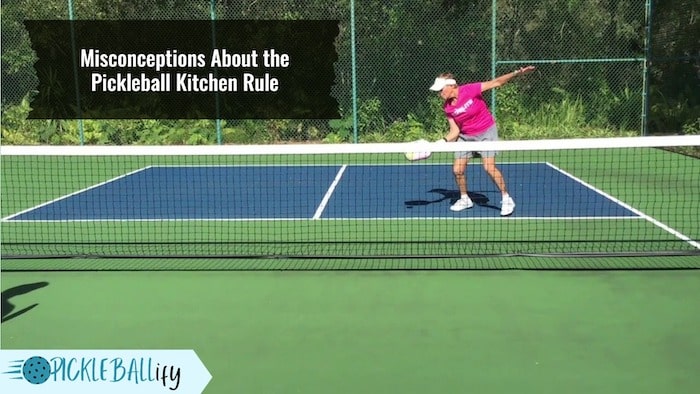
1) Holding the paddle incorrectly – Holding the paddle incorrectly is one of the most common mistakes beginners make when playing pickleball. The correct way to hold the paddle is to place your hand on the handle with your fingers wrapped around the grip, and your thumb resting on the flat part of the paddle face.
This is called the continental grip, and it allows you to hit forehand and backhand shots with ease. Avoid holding the paddle like a tennis racket or a frying pan, as this will limit your range of motion and accuracy.
2) Staying in no man’s land – Staying in no man’s land means standing in the area between the baseline and the kitchen line. This is a very bad position to be in, as it exposes your feet too low shots, gives your opponents more angles and space to hit dinks, and makes your dinks more difficult because you are farther from the net.
You should always try to get to the kitchen line as soon as possible after serving or returning serve, unless you have a good reason to stay back.
3) Hitting the opponent’s forehand – Hitting the opponent’s forehand is another common mistake that beginners make when playing pickleball. Most players are stronger and more comfortable on their forehand side, so hitting there will only make their shots easier and more effective.
Instead, you should try to hit their backhand side, which is usually weaker and less consistent. You can also mix up your shots by hitting their middle or body, which can cause confusion and hesitation.
4) Touching the kitchen line or zone while volleying – Touching the kitchen line or zone while volleying is a fault that will cost you points and games.
You should always keep your paddle up and away from the kitchen when volleying, and avoid jumping or lunging into the kitchen after volleying. You should also communicate and coordinate with your partner to avoid touching each other or crossing into each other’s space while volleying.
How to Practice and Improve Your Pickleball Kitchen Skills
Playing in the pickleball kitchen requires a lot of practice and repetition. You need to develop muscle memory, accuracy, consistency, and confidence in your shots. You also need to work on your footwork, balance, and reaction time. Here are some drills that you can do to practice and improve your pickleball kitchen skills:
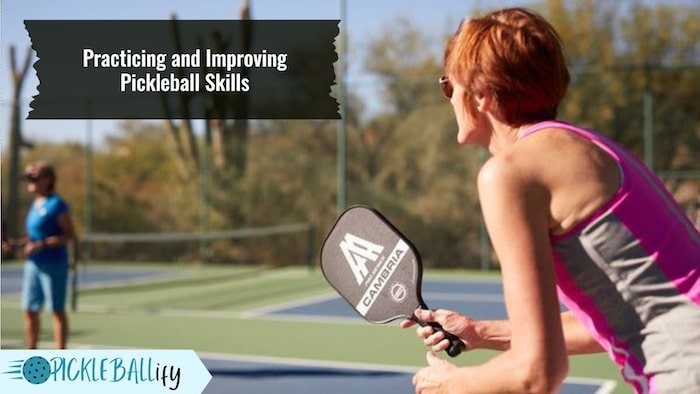
Dink for Points
This is a simple and fun drill that works on your dinking skills and endurance. You play pickleball just as you usually would, but you’re only going to hit one side of the court. You can do straightaway dinking or cross-court dinking, depending on what you need to work on.
You keep score as normal, but you only get a point if you win the rally with a dink. This drill will help you improve your dink placement, consistency, and strategy.
Two-Ball Dink
This is a challenging drill that works on your dinking skills and concentration. You stand on each side of the net with a partner at the kitchen line. You each should have a ball. Start dinking your balls at the same time. As soon as you hit a dink, you’ll have to be watching for your partner’s ball coming your way.
Try to keep both balls in play as long as possible. This drill will help you improve your dink timing, accuracy, and awareness.
Kitchen Rules
This is a dynamic drill that works on your footwork and transition skills. You stand at the baseline with a partner at the kitchen line. Your partner feeds you a ball that bounces near the kitchen line. You run up to hit a dink and then run back to the baseline.
Your partner feeds you another ball that bounces near the baseline. You run up to hit another dink and then run back again. Repeat this pattern as many times as you can. This drill will help you improve your speed, agility, and balance.
Wall Drill
This is a solo drill that works on your volley and drops shot skills. You find a wall with enough space around it to hit the ball. You start at the kitchen line and hit the ball high off of the wall. Drop step with your paddle-side foot and side shuffle until you are under the ball.
Hit a volley or a drop shot back to the wall and repeat the process. This drill will help you improve your shot selection, control, and reaction.
FAQs
The kitchen is a critical area in pickleball as it affects the flow, strategy, and tactics of the game. It helps prevent players from smashing the ball right at the net, which would make the game overly aggressive and less strategic. The kitchen also promotes dinking, a soft, controlled shot that keeps the ball low and forces opponents to play defensively, leading to more skillful and strategic play.
Yes, players are allowed to stand in the kitchen in pickleball as long as they do not volley the ball from within the kitchen. Players can hit the ball after it bounces in the kitchen or hit it while standing outside the kitchen
No, players are not allowed to step into the kitchen after hitting the ball in pickleball, even if the ball bounces in the kitchen. The foot must remain behind the kitchen line to avoid a violation.
Yes, there are some exceptions to the kitchen rules in pickleball. If a player is forced into the kitchen by an opponent’s shot, such as a ball that bounces in the kitchen or a shot that forces them to step into the kitchen, they are not committing a fault. However, they must exit the kitchen without hitting the ball.
Conclusion
In conclusion, the kitchen rules in pickleball are a critical aspect of the game that every player should understand and adhere to. Being aware of the no-volley zone, knowing when and how to play shots from the kitchen, and avoiding violations can greatly impact your gameplay and give you an advantage on the court.
By mastering the art of dinking, utilizing drop shots, staying on your toes, communicating with your partner, and practicing your skills, you can effectively use the kitchen to control the game and outplay your opponents.
So, next time you step onto the pickleball court, remember to keep these kitchen rules in mind and take advantage of this strategic zone to elevate your pickleball game to new heights! Happy pickleball playing!

